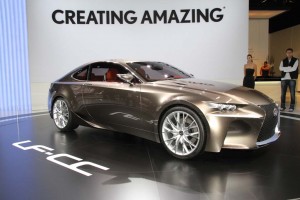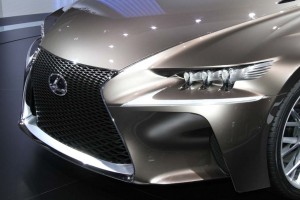Lexus has been dropping a number of surprises in recent months – all meant to demonstrate that it’s serious about pumping more “passion” into the brand.
The latest effort, the LF-CC Concept, may be the most aggressive example of that to date, taking the maker’s L Finesse design language to new extremes — with a bold new iteration of the Lexus spindle grille that has become the symbol of the brand’s new direction.
Likely to return in production form, the Lexus LF-CC is making its formal debut at this year’s Paris Motor Show. And it also emphasizes that the Japanese brand’s love affair with hybrid technology isn’t cooling down.
The brand’s U.S. boss, Mark Templin, told TheDetroitBureau.com last month that by mid-decadeLexus will have eight, possibly even nine, gas-electric offerings in its line-up.
Whether the LF-CC will become one of those models remains to be seen but unlike some show cars the concept on the Paris show floor has the sort of polished details that suggest it could be testing the waters for a planned production model.
Targeting the midsize, or D-, segment, the LF-CC boasts the latest iteration of the Lexus L-finesse design language – starting with the increasingly familiar “spindle” grille, here framed by the lip of the hood and, below, by a deep lower spoiler, the grille mesh itself encased in a metal-finish surround giving the nose a sculpted appearance. Narrow headlamps feature an unusual 3 LED-projector design with separate Daytime Running Lights integrated into the bumper surface.
The overall design was carefully tailored to maximize aerodynamics, according to Lexus, the lower fenders meant to manage air flow to both the engine and front brakes. The rear fenders are notably less pronounced than those up front.
Like both the LF-LC concept and the LFA production supercar, airflow has been carefully managed underneath the vehicle, as well to maximize downforce. Sculpted fins flow from underneath the LF-CC and upwards through the wheel arches to merge with the falling roofline – creating a large rear spoiler.
Unlike previous dedicated hybrid models that suffered from a bit of the wimp factor, the Lexus LF-CC appears to aimed at presenting a strong and aggressive stance.
The show car is finished in what Lexus calls a “Fluid Titanium” paint, a high-gloss metallic finish that helps emphasize the body’s form.
Inside, the Lexus LF-CC follows the brand’s HMI, or Human Machine Interface, design philosophy, with the instrument panel divided into an upper “Display Zone,” including a large multi-display screen, and a lower “Operation Zone” for various knobs and switches, as well as what Lexus promises is a “uniquely designed shift lever and an innovative touch tracer display for remote system control.”
Contrasting the cool Fluid Titanium exterior, the cabin is trimmed in warmer amber leather with metallic accents.
Under the skin, the Lexus LF-CC is powered by a 2.5-liter inline-four gas engine paired with a single, high-output, water-cooled electric motor. The maker is holding back specific details such as horsepower and torque, as well as specifics on the battery system used, but it appears to be a different drivetrain package than has been in use in such prior Lexus models as the dedicated HS 250h hybrid and the new Lexus LS 600h flagship.
The Japanese maker does note that the LF-CC’s CO2 emissions are “targeted below 100 g/km,” or grams per kilometer. It adds that the “powertrain will achieve class-leading energy efficiency, with more than 2 hp produced per gram of CO2.” A quick bit of math might suggest that translates into something in the 200 hp range.
And while it remains to be seen if the LF-CC design will reappear in production form, as is, Lexus says the new drivetrain very definitely has a future in its upcoming line-up.


